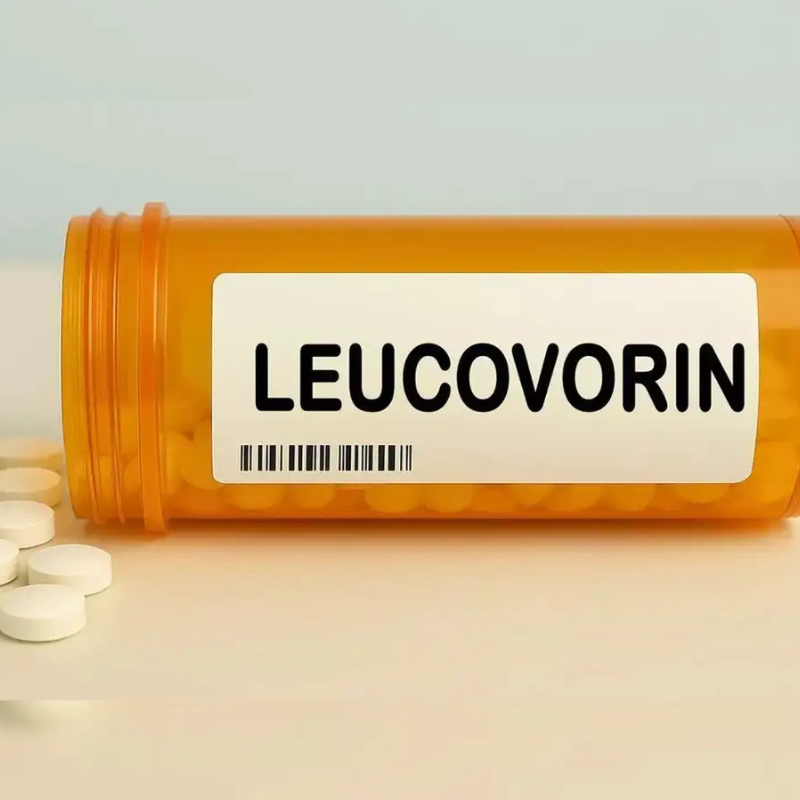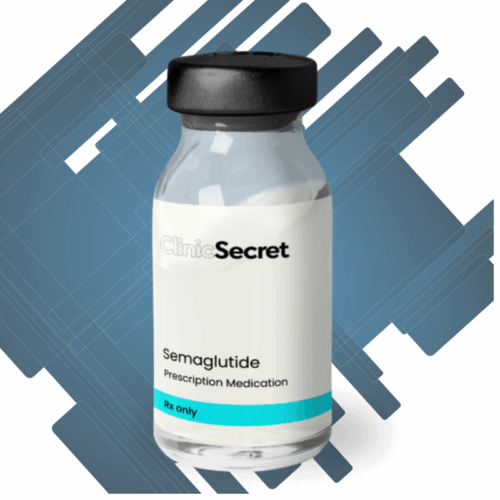Leucovorin is a vital form of folic acid designed to help your body produce and maintain new cells. Ideal for mitigating side effects from high doses of medications like methotrexate, this oral tablet helps ensure your well-being during treatment. Available in multiple dosages (5 mg, 10 mg, 15 mg, 25 mg), Leucovorin is an essential antidote that empowers your body's natural defenses. Choose Leucovorin for effective support, peace of mind, and a healthier path through your medical journey. Trust in Leucovorin to enhance your health today!
Description
Leucovorin, also known as folinic acid, occupies a unique position in modern pharmacology as a vital “rescue agent” that helps safeguard healthy cells from the toxic effects of certain chemotherapeutic and antimicrobial drugs. Unlike folic acid, which must be enzymatically converted into its active form, leucovorin is biologically active and ready to participate directly in folate-dependent biochemical processes. This seemingly subtle distinction has far-reaching implications across oncology, infectious disease, and hematology.
In this blog, we’ll explore the science behind leucovorin — its mechanism of action, indications for use, key medical applications, dosing principles, potential side effects, and emerging research directions that could further expand its role in clinical medicine.
What Is Leucovorin?
Leucovorin is a reduced form of folic acid, also called 5-formyltetrahydrofolate. It belongs to a family of compounds collectively known as folates — water-soluble B vitamins essential for DNA synthesis, cell division, and the metabolism of amino acids. Because leucovorin bypasses the enzymatic steps required for activation, it can quickly replenish intracellular folate stores when normal metabolism is blocked or impaired.
This makes leucovorin invaluable in situations where drugs such as methotrexate or pyrimethamine inhibit folate-dependent enzymes, resulting in severe depletion in rapidly dividing cells, such as those in the bone marrow and gastrointestinal mucosa.
Historical Background
The origins of leucovorin’s use date back to the early 1950s, when researchers discovered that certain folate analogs could interfere with cancer cell growth but also cause toxicity in healthy tissue. Scientists soon realized that folinic acid could selectively “rescue” normal cells without compromising anticancer efficacy if administered at the right time after methotrexate therapy.
This discovery revolutionized chemotherapy protocols and led to the concept of “leucovorin rescue,” now a cornerstone in oncologic pharmacotherapy. Over time, its utility expanded to include antimicrobial therapy (for conditions such as toxoplasmosis) and nutritional support in certain megaloblastic anemias.
Pharmacological Mechanism
Leucovorin acts as a coenzyme in one-carbon transfer reactions, serving as a carrier of activated one-carbon units essential for the synthesis of thymidylate and purines — the building blocks of DNA and RNA.
In patients receiving methotrexate, a dihydrofolate reductase (DHFR) inhibitor, folate metabolism is inhibited, resulting in reduced DNA synthesis and cell death. Leucovorin circumvents this blockade by directly providing tetrahydrofolate derivatives, which are needed for nucleotide synthesis, thereby protecting normal cells from cytotoxicity.
However, this same mechanism can also enhance the activity of certain drugs, such as 5-fluorouracil (5-FU), by stabilizing the binding of the fluorouracil metabolite FdUMP to thymidylate synthase, thereby intensifying its anticancer effect. This dual role makes leucovorin one of the few agents used both to protect and potentiate chemotherapy.
Clinical Indications
Leucovorin has several FDA-approved and off-label clinical uses. Its primary indications include:
1. Methotrexate Rescue Therapy
After high-dose methotrexate administration, leucovorin is given 24–36 hours later to protect healthy cells from irreversible toxicity. This is crucial for preventing bone marrow suppression, mucositis, hepatotoxicity, and nephrotoxicity. The timing, dose, and duration of leucovorin rescue are determined by serum methotrexate levels and renal function.
2. Enhancement of 5-Fluorouracil Therapy
Leucovorin enhances the binding of 5-FU to thymidylate synthase, thereby increasing the potency of the chemotherapeutic effect. This combination is commonly used in colorectal cancer regimens, such as FOLFOX (Folinic acid, 5-FU, and Oxaliplatin) and FOLFIRI (Folinic acid, 5-FU, and Irinotecan).
3. Treatment of Megaloblastic Anemia
In cases of folate deficiency due to malnutrition, malabsorption, or chronic alcoholism, leucovorin can help replenish functional folate stores. However, it must never be used to treat anemia caused by vitamin B12 deficiency, as it can correct hematologic symptoms while masking neurologic damage.
4. Toxoplasmosis and Pneumocystis jirovecii Infection
When pyrimethamine or trimethoprim-sulfamethoxazole is used to treat opportunistic infections, leucovorin is co-administered to reduce bone marrow suppression. This is especially important in immunocompromised individuals, such as those with HIV/AIDS.
5. Antidote for Folate Antagonist Overdose
Accidental or intentional overdose of methotrexate or similar drugs can cause life-threatening toxicity. Immediate leucovorin rescue, along with hydration and urine alkalinization, can significantly improve outcomes.
Pharmacokinetics and Metabolism
After oral or parenteral administration, leucovorin is rapidly absorbed and widely distributed throughout body tissues. The active form, 5-methyltetrahydrofolate, crosses cell membranes easily and participates in intracellular folate metabolism.
Peak plasma levels occur within 1–2 hours following oral dosing, while the elimination half-life ranges from 3 to 6 hours. Leucovorin and its metabolites are primarily excreted in the urine.
Dosage and Administration
Leucovorin is available in oral, intramuscular (IM), and intravenous (IV) formulations.
Typical dosing guidelines vary according to indication:
- Methotrexate rescue: 10–15 mg/m² IV every 6 hours for 10 doses, adjusted per methotrexate level.
- 5-FU modulation: 20 mg/m² IV bolus or 200–500 mg/m² continuous infusion with each cycle.
- Toxoplasmosis adjunct: 10–25 mg orally once daily during pyrimethamine therapy.
Close monitoring of plasma methotrexate levels and renal function is essential during therapy. Overdosing leucovorin may interfere with antitumor efficacy, while underdosing increases toxicity.
Adverse Effects
Leucovorin is generally well-tolerated, but side effects can occur, particularly when used alongside chemotherapy. Reported adverse reactions include:
- Nausea, vomiting, or diarrhea
- Stomatitis (mouth inflammation)
- Allergic reactions (rash, urticaria, rare anaphylaxis)
- Sleep disturbances or irritability in some patients
- Seizures in predisposed individuals (especially those on anticonvulsants)
Most side effects are mild and transient. However, in oncology settings, the distinction between drug-induced toxicity and underlying disease symptoms can be challenging.
Drug Interactions
Leucovorin interacts with several medications:
- Methotrexate: Counteracts toxicity (therapeutic use).
- 5-Fluorouracil: Enhances cytotoxic effect.
- Trimethoprim or Pyrimethamine: Reduces risk of marrow suppression.
- Anticonvulsants (phenytoin, phenobarbital, primidone): May decrease serum concentrations of these drugs, reducing seizure control efficacy.
Clinicians must carefully manage such interactions to balance efficacy with safety.
Leucovorin vs. Folic Acid: Key Differences
While both compounds share a similar structure and biochemical role, there are critical differences:
| Feature | Folic Acid | Leucovorin (Folinic Acid) |
|---|---|---|
| Activation | Requires DHFR for conversion | Biologically active |
| Use in Methotrexate Toxicity | Ineffective | Effective “rescue” agent |
| Role in Cancer Therapy | None | Enhances 5-FU efficacy |
| Availability | OTC supplement | Prescription medication |
This distinction highlights why leucovorin is considered a pharmacological agent, not merely a vitamin supplement.
Research Insights and Emerging Applications
Modern research continues to explore new ways leucovorin can be leveraged therapeutically:
- Combination Chemotherapy: Trials are assessing optimal dosing strategies of leucovorin with 5-FU and oxaliplatin for advanced gastrointestinal cancers.
- Genetic Predictors of Response: Variations in folate pathway genes (such as MTHFR polymorphisms) may influence how patients respond to leucovorin-modulated chemotherapy.
- CNS Applications: Experimental studies are investigating leucovorin in neurological disorders involving folate transport or metabolism, such as cerebral folate deficiency and certain subtypes of autism spectrum disorder.
- Adjunctive Role in Infections: Research on protozoal and parasitic infections suggests leucovorin can enhance safety in prolonged antiparasitic treatments.
These evolving findings highlight leucovorin’s versatility beyond traditional oncology.
Safety Considerations
While leucovorin is relatively safe, several precautions are necessary:
- Avoid in Pernicious Anemia: May mask hematologic symptoms without correcting neurological deficits from B12 deficiency.
- Monitor in Renal Impairment: Delayed methotrexate clearance can lead to toxicity even with rescue therapy.
- Pregnancy and Lactation: Use only if benefits outweigh risks; data on fetal safety are limited.
- Drug-Drug Monitoring: Adjust doses of anticonvulsants or chemotherapy agents as needed.
Clinicians often use serum folate and methotrexate levels to tailor therapy precisely.
Global Health Perspective
Leucovorin plays a significant role in global medicine, particularly in regions where antifolate drugs are used widely for malaria or opportunistic infections. Access to leucovorin can dramatically reduce morbidity associated with drug-induced folate deficiency.
In oncology, the inclusion of leucovorin in standardized chemotherapy regimens like FOLFOX has improved survival rates for colorectal cancer worldwide. However, access disparities remain a challenge in low-income countries, where both methotrexate and leucovorin may be inconsistently available.
Storage and Stability
Leucovorin should be stored at controlled room temperature, protected from light. Reconstituted IV solutions should be used promptly or refrigerated per the manufacturer's instructions. Because folate derivatives are sensitive to light and oxidation, proper handling is essential to ensure potency and patient safety.
Future Outlook
As precision medicine advances, the role of leucovorin may evolve further. Personalized dosing based on pharmacogenomic profiles might improve efficacy while minimizing toxicity. Furthermore, research into new analogs of folinic acid could yield drugs with improved stability and selectivity.
In the next decade, leucovorin is expected to remain indispensable in chemotherapy support protocols and in the management of folate antagonist toxicity. Its dual function — as both protector and potentiator — continues to make it one of the most fascinating molecules in clinical pharmacology.
Conclusion
Leucovorin stands as a testament to the intricate interplay between biochemistry and therapeutic innovation. From its early use as a simple folate derivative to its central role in modern cancer therapy, it exemplifies how a deep understanding of metabolic pathways can translate into lifesaving treatments.
Whether safeguarding patients from the harsh effects of chemotherapy or enhancing the power of anticancer drugs, leucovorin embodies the principle of precision pharmacology — targeted intervention with maximum benefit and minimal harm. As ongoing research continues to uncover new uses, leucovorin’s legacy in medicine remains not just historical but profoundly forward-looking.
Frequently Asked Questions (FAQs) About Leucovorin
1. What is Leucovorin and how does it differ from folic acid?
Leucovorin is a biologically active form of folic acid, also known as folinic acid. Unlike folic acid, which must be converted by the enzyme dihydrofolate reductase (DHFR) into its active form, leucovorin can directly participate in DNA and RNA synthesis. This property allows it to bypass metabolic blockades caused by drugs like methotrexate.
2. Why is Leucovorin used after methotrexate treatment?
Methotrexate blocks folate metabolism to kill cancer cells, but this also harms healthy cells. Leucovorin “rescues” normal cells by supplying active folate, allowing them to recover and continue DNA synthesis. This practice is known as leucovorin rescue therapy and is essential in preventing life-threatening toxicity from methotrexate.
3. Can Leucovorin be used as a vitamin supplement?
No. Although it is related to folate, leucovorin is a prescription medication used for specific therapeutic purposes. It should not replace dietary folate or be used as a routine vitamin supplement unless directed by a healthcare provider.
4. How is Leucovorin administered?
Leucovorin can be given orally, intramuscularly (IM), or intravenously (IV), depending on the condition being treated. In oncology settings, the intravenous route is most common because it allows precise control of dosing during chemotherapy.
5. What are the most common side effects of Leucovorin?
Leucovorin is generally safe, but mild effects like nausea, vomiting, diarrhea, or skin rash can occur. When used with chemotherapy, more severe symptoms may arise from the combined drug regimen rather than leucovorin alone. Rarely, allergic reactions or seizures have been reported.
6. Can Leucovorin be used during pregnancy or breastfeeding?
There is limited data on leucovorin use during pregnancy and breastfeeding. It is typically used only if the potential benefits outweigh the risks. Pregnant women receiving chemotherapy may require special monitoring when leucovorin is included in treatment.
7. What happens if someone takes too much Leucovorin?
Leucovorin overdose is uncommon but can reduce the effectiveness of folate antagonist drugs like methotrexate. In some cases, excessive leucovorin may interfere with chemotherapy efficacy. Medical supervision and regular blood tests are essential to ensure proper dosing.
8. What drugs interact with Leucovorin?
Leucovorin can interact with several medications, including:
- Methotrexate (counteracts its toxicity)
- 5-Fluorouracil (5-FU) (enhances its effect)
- Trimethoprim and Pyrimethamine (reduces bone marrow toxicity)
- Anticonvulsants like phenytoin and phenobarbital may lower their blood levels)
Always inform your healthcare provider about all medications and supplements you are taking before starting leucovorin.
9. Is Leucovorin safe for people with vitamin B12 deficiency?
No. Leucovorin should not be used in individuals with pernicious anemia or B12 deficiency. It can correct the anemia temporarily but will not prevent neurological damage caused by the lack of vitamin B12.
10. What ongoing research is being done on Leucovorin?
Current research explores leucovorin’s use in new chemotherapy combinations, its role in genetic-based dosing (pharmacogenomics), and its potential benefits in neurological disorders related to folate metabolism. Scientists are also studying how to optimize leucovorin’s timing and dosage to enhance cancer therapy outcomes with fewer side effects.




